The Bay Trail Preview: Intel Atom Z3770 Tested
by Anand Lal Shimpi & Brian Klug on September 11, 2013 12:00 PM EST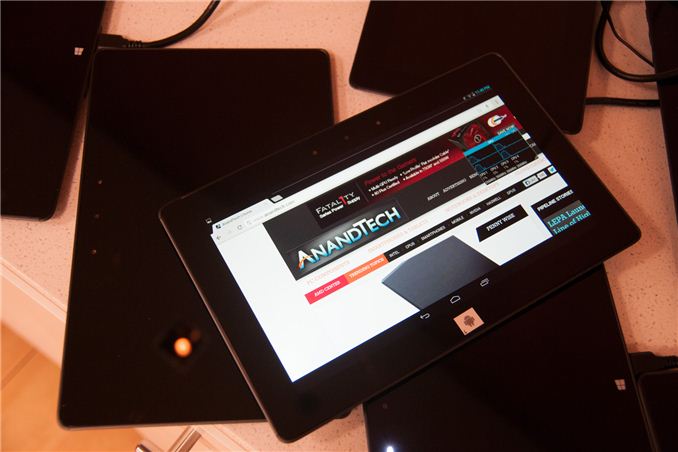
Earlier this year Intel unveiled Silvermont, its first true architectural update to Atom since its introduction in 2008. I won’t rehash Silvermont’s architecture here, but it’s designed to be a true test of Intel’s performance in the ultra mobile space. Leveraging Intel’s first 22nm SoC process and a very low power/efficient microarchitecture, Silvermont aims squarely at the latest Krait cores from Qualcomm and ARM’s Cortex A15.
Today Intel takes the next step forward, introducing the first tablet SoC based on Silvermont: Bay Trail.
Bay Trail takes up to four Silvermont cores, and for the first time in an ultra mobile Intel SoC pairs them with Intel’s own graphics IP. That’s right, rather than using a GPU block from Imagination Technologies, Bay Trail leverages the same GPU architecture as Ivy Bridge.
The first Bay Trail tablets will be shipping by the end of the year, across both Android and Windows 8.1. Intel expects Bay Trail to show up in tablets and 2-in-1s priced below $599, with everything above $599 falling under Haswell’s jurisdiction.
Bay Trail & Branding
Bay Trail, like all Atom platforms before it, will be available in multiple form factors. Unlike the Atoms of yesterday however, the SoC will carry Pentium and Celeron branding when used in notebooks and desktops. Intel didn’t disclose too much about its Silvermont plans in other form factors other than some basic naming:
Basically notebooks ship under the Pentium N3000 & Celeron N2000 series, while desktops will carry Pentium J2000 & Celeron J1000 branding. All Pentium SKUs seem to be quad-core, while Celeron SKUs will be available in both dual and quad-core versions.
Thankfully Intel shied away from introducing the same complexity with its tablet focused Bay Trail parts. All Bay Trail tablet SKUs carry Atom branding. There’s the quad-core Z3700 series and the dual-core Z3600 series.
Although Intel offers both dual and quad-core Bay Trail SKUs, they are both based on the same single physical design. In other words, dual-core Bay Trail parts are just die harvested quad-core parts. Intel isn’t disclosing die size or transistor counts, which is ironic (and disappointing) given that Apple just disclosed both (or at least relative magnitude of one) for its A7 SoC.
Internally, the Bay Trail design is pretty nice. There are either two or four cores enabled, each pair with a shared 1MB L2 cache (2MB total for a quad-core part). Intel is following the unfortunate lead of everyone else in the mobile industry and advertising max turbo frequencies exclusively.
Thankfully Intel hasn’t yet decided to obfuscate max non-turbo frequencies:
| Bay Trail Turbo Speeds | ||||||||
| Z3770 | Z3770D | Z3740 | Z3740D | Z3680 | Z3680D | |||
| Max turbo frequency | 2.39GHz | 2.41GHz | 1.86GHz | 1.83GHz | 2.0GHz | 2.0GHz | ||
| Max non-turbo Frequency | 1.46GHz | 1.5GHz | 1.33GHz | 1.33GHz | 1.33GHz | 1.33GHz | ||
In general you’re looking at 1.33GHz - 1.46GHz max non-turbo frequencies, with Bay Trail being able to turbo up to anywhere between 1.83GHz and 2.40GHz depending on SKU.
Although the core architecture is 64-bit in design, there will be no OS support for 64-bit Bay Trail at launch. Windows 8.1 with Connected Standby appears to still be 32-bit only, and obviously Android is 32-bit only at this point as well.
The memory interface is fairly ridiculous by mobile standards. You either get two 64-bit LPDDR3 channels (128-bit total width) or a single 64-bit DDR3L channel. In the case of the former, that’s the same memory bus width as Apple’s A5X/A6X line of SoCs as well as the standard Core i3/i5/i7 parts. Max supported memory frequency is 1066MHz in dual-channel LPDDR3 mode, or 1333MHz in single-channel DDR3L mode. The only benefit to the latter is really cost, as Bay Trail will purportedly show up in some very cheap devices.
The GPU is Intel’s own Gen7 graphics core, a cut down implementation of what we first saw in Ivy Bridge. I suppose it’s premature to expect Merrifield, Bay Trail’s smartphone counterpart, to also use Intel’s own graphics core but it’s clear this is the direction Intel is headed in - and away from licensing IP from Imagination Technologies.
Rather than 16 EUs in the Ivy Bridge GT2 configuration (HD 4000), Bay Trail’s HD Graphics core ships with 4. The 4 EUs are otherwise effectively identical to what we found in Ivy Bridge. The GPU can dynamically scale frequency and share power between itself and the CPU cores. Minimum GPU frequency on Bay Trail is 311MHz and a max GPU frequency of 667MHz (or 688MHz for the DDR3L SKUs).
Intel is quick to point out that Bay Trail’s GPU supports DirectX 11 and OpenGL ES 3.0. Unfortunately this support list appears limited to Windows. Under Android, it’s unclear whether or not Bay Trail will ship with anything above OpenGL ES 2.0 support. The same goes for GPU accelerated Renderscript. Bay Trail supports up to 2560 x 1440 displays over eDP1.3/DP1.2, or 1080p over HDMI. Panel Self Refresh is also supported.
Video encode and decode blocks also shifted away from Imagination in Bay Trail. Both IP blocks are custom from Intel now. The ISP (Image Signal Processor) is from Silicon Hive (an Intel acquisition).


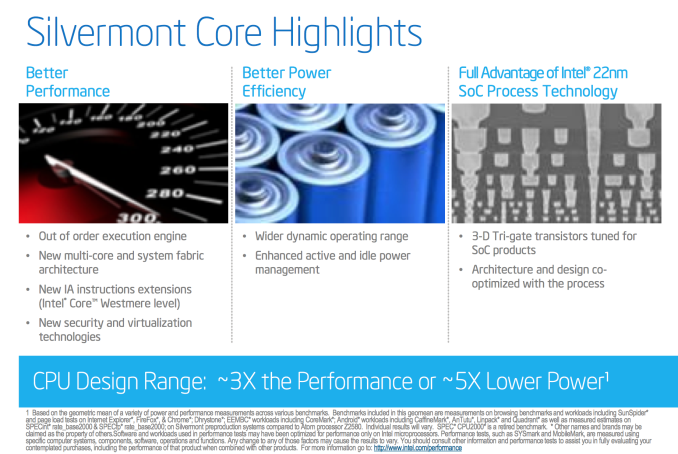
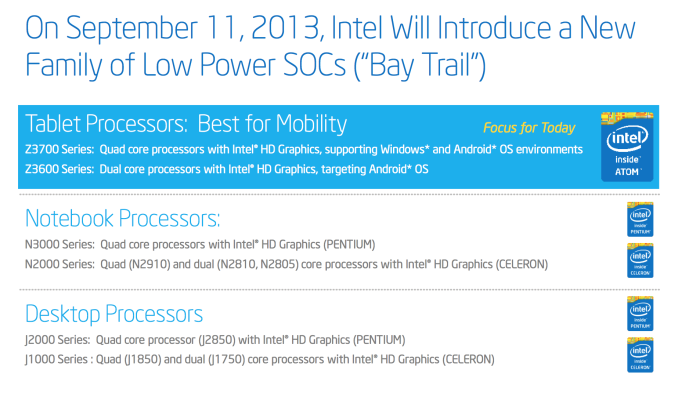
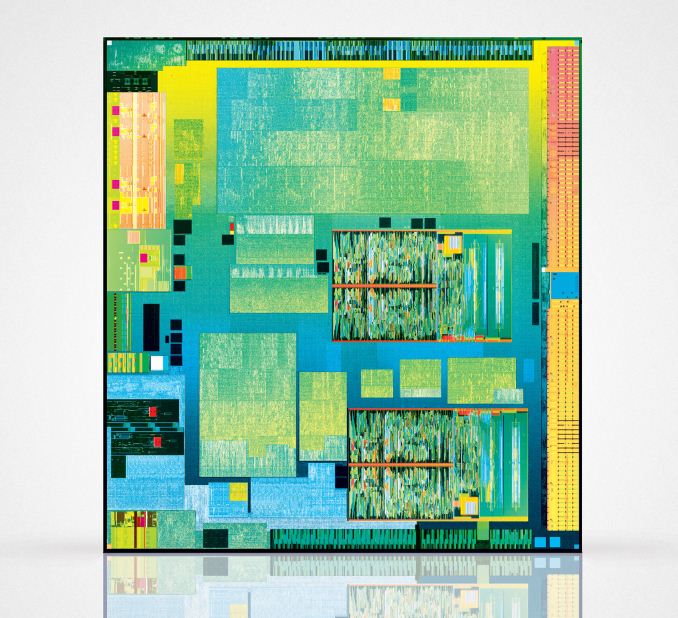
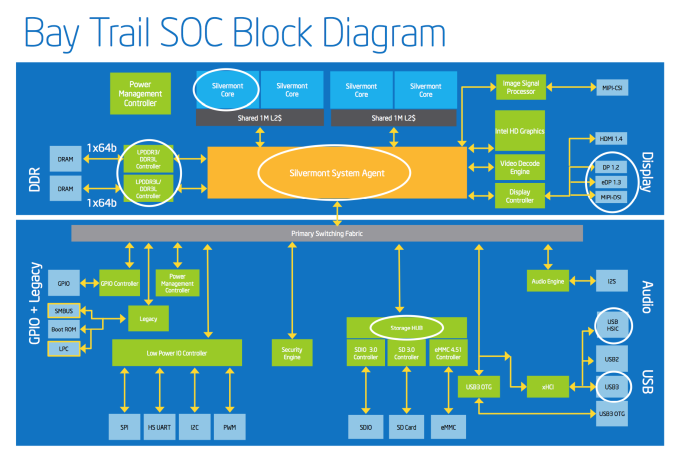
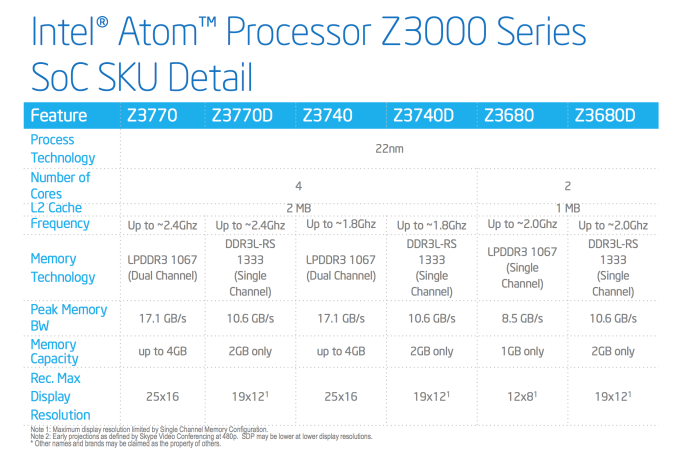
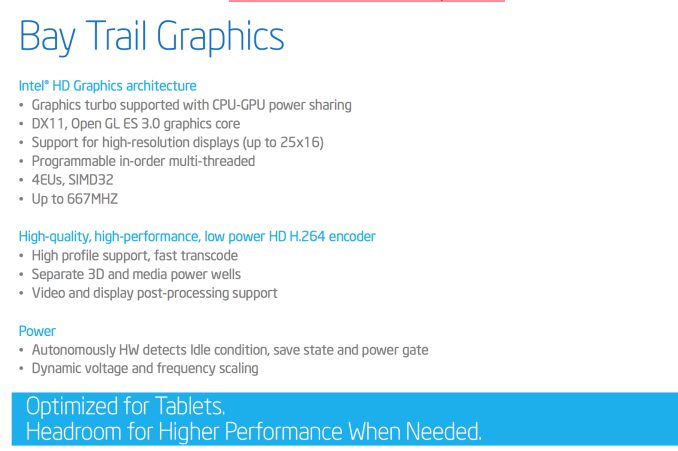
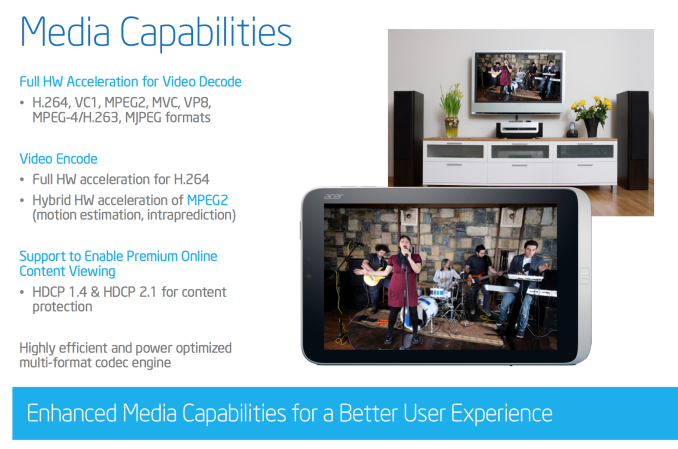








190 Comments
View All Comments
Homeles - Wednesday, September 11, 2013 - link
I'd wake you up right now, but I'm not sure I'd want to risk you spreading your ignorance to others.zeo - Wednesday, September 11, 2013 - link
Medfield and Clover Trail+ ATOM are already being used in phones and tablets... the direct upgrade is called Merrifield and will be launched early next year but aside from being coupled with a LTE modem it's still based on the same Silvermont Architecture as this Bay Trail model!While Bay Trail is even more energy efficient than the previous Clover Trail ATOM! The Z3770 is providing roughly twice the performance but using no more power than the previous Z2760 Clover Trail, which was a 3W TDP rated SoC...
So battery life would only be worse if they coupled it with energy hogging parts like a 2560x1600 resolution screen for example... The back lighting alone would increase power consumption by up to 30%...
Asus had issues getting good enough battery life for their Tegra 4 updated Infinity Transformer model as well because they used that high resolution screen, for example...
Homeles - Wednesday, September 11, 2013 - link
This is truly incredible. I did not think that Silvermont would outperform Kabini, especially given that Kabini has a much, much higher TDP.It's amazing -- AMD's Jaguar cores have been utterly invalidated. Kabini still has quite the graphics advantage, but at with a power draw several times higher than Bay Trail. This lead will only be exacerbated when Intel's 14nm Airmont drops in next year.
This is truly unbelievable. The question of who will win the ARM war has been answered.
It took 5 years of pain, but it seems like the wait was worth it.
Da W - Wednesday, September 11, 2013 - link
I prefer a Kabini tab all the way. Where did you see such outrageous outperformance? CPU cores are better on some tests, graphics get pounded by AMD it's not even funny.Kabini would give me all the CPU power i need from a tablet, and i prefer more GPU power. Don't really care about power draw, i own a surface pro, anything would be an improvement.
Homeles - Wednesday, September 11, 2013 - link
Fortunately for Intel, and my argument, OEMs DO care about power.Also, just as an FYI, the A4 Kabini chip here is a 15W part. You won't see that in Tablets (or are at least very unlikely to).
icetorch - Wednesday, September 11, 2013 - link
What I'd like to know is if they will compete in the same price range.zeo - Wednesday, September 11, 2013 - link
Bay Trail cost Intel less to make than the previous ATOM, thanks in part to the move to the 22nm FAB... which is much better developed now than when Intel introduced it with Ivy Bridge. So they're pushing for even lower pricing, which at best you might find Temash competing with but not Kabini...Mind, 15W TDP means the need for active cooling and that means larger designs, more materials, etc. that tend to raise costs versus fan-less designs that the Bay Trail T models will go into...
There are already two design wins for 8" tablets that look like they'll be barely priced over $300 and run full Windows 8.1... And they can go cheaper if they release it with Android instead... Never mind the lower end version of Bay Trail... the Z3770 is a quad core but they can go down to dual and even single core models...
ancientarcher - Thursday, September 12, 2013 - link
"Bay Trail cost Intel less to make than the previous ATOM, thanks in part to the move to the 22nm FAB... "Dream on... the previous Atom was 32nm and BayTrail is 22nm trigate. In which universe is BayTrail going to be cheaper?? Maybe if the area of the BayTrail were 1/3rd that of the 32nm Atom, which was, what around 120mm^2. Using trigate and double patterning is not cheap!
Secondly, people have mentioned that power consumption should be better than Snapdragon 800. Really!! Snapdragon 800 is in phones which means it's power consumption is lower than a tablet-only chip like the Baytrail. Had Baytrail been that super duper good on power consumption, rest assured, they would have put it in a smartphone...
Maybe if we had used some non-javascript based benchmarks (the new geekbench 3.0 anyone) we would have seen where the Baytrail chip is in relation to the best in the ARM camp with regards the CPU. As it is, we know that Baytrail is soundly beaten in the GPU department and the general Anandtech fluff on CPU benchmarks makes it difficult to say who is where on the CPU front... Maybe the scammed AnTuTu benchmark would also have helped Intel. Wonder why Anand didn't put it in...
JPForums - Thursday, September 12, 2013 - link
They are going to put it into a smartphone with Merrifield. As I understand it, the reason Bay Trail is targeted at tablets while Merrifield is targeted as phones is mostly the integration of a modem into Merrifield. Phone makers tend to shy away from multi-chip solutions if they have other options given the space premium in phones. I'm sure lower clocked parts and/or dual core offerings will available (just like its ARM counterparts), but the architecture is still the same 22nm Silvermont found in Bay Trail.
zeo - Thursday, September 12, 2013 - link
No dream, just reality! Intel's 22nm FAB is on its second gen, they got costs down and the ATOM is a far smaller and cheaper chip to produce than Intel's Core series. So yes, costs are down... really, look at the pricing of the devices being announced at IDF! They're all much cheaper than the when Clover Trail based devices first came out!And Silvermont is going into phones, it'll replace the present Medfield and Clover Trail+ early next year when they release Merrifield!